Hey!

Hey!
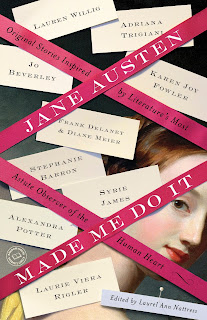 It’s always fun to share a cover, and here’s a very lovely one–a short story anthology of stories inspired by Jane Austen, edited by Laurel Ann Nattress and to be released in October, 2011. Jane Austen Made Me Do It can be preordered now!
It’s always fun to share a cover, and here’s a very lovely one–a short story anthology of stories inspired by Jane Austen, edited by Laurel Ann Nattress and to be released in October, 2011. Jane Austen Made Me Do It can be preordered now!
A whole bunch of us are participating–you may recognize some of those names on the cover–and mine, Jane Austen, Yeah, Yeah, Yeah, is probably the only one about Beatlemania in the collection. It was inspired not so much by Jane Austen, although the story is, sort of, about Sense and Sensibility, but by the movie An Education.
When I saw the cover I was curious about the painting used, and Laurel Ann told me it was Portrait of the Misses Mary and Emily McEuen by Thomas Sully (June 19, 1783 – November 5, 1872).
 I was curious about Sully, and his name was familiar, so I thought today I’d tell you a bit about him. First, here’s the whole portrait. Sully was born in England to a family of actors who traveled to Richmond, VA, where his uncle managed a theater. His artistic talent was a family trait and his first real apprenticeship was with an elder brother and then briefly with Gilbert Stuart.
I was curious about Sully, and his name was familiar, so I thought today I’d tell you a bit about him. First, here’s the whole portrait. Sully was born in England to a family of actors who traveled to Richmond, VA, where his uncle managed a theater. His artistic talent was a family trait and his first real apprenticeship was with an elder brother and then briefly with Gilbert Stuart.
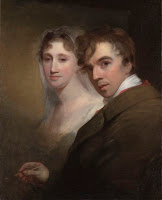 When his brother died, Thomas, at the age of twenty-one, then married his brother’s widow (his self portrait shows him painting his wife), becoming stepfather to his nieces and nephews and fathering nine more. He moved to Philadelphia, his home base, in 1806, and in 1809 made a visit to London to study with Benjamin West and Thomas Lawrence.
When his brother died, Thomas, at the age of twenty-one, then married his brother’s widow (his self portrait shows him painting his wife), becoming stepfather to his nieces and nephews and fathering nine more. He moved to Philadelphia, his home base, in 1806, and in 1809 made a visit to London to study with Benjamin West and Thomas Lawrence.
His own records indicate a staggering 2,631 works from 1801 onward, mostly portraits, although he also painted some landscapes and dramatic historical scenes. During his long life, his subjects included Thomas Jefferson, John Quincy Adams, Lafayette, and Decatur, but his portraits of women were most admired for their sympathy and sensuality.
 In 1837, America was in a recession and he left for London with his daughter Blanch to look for work. The day before his departure, the Society of the Sons of Saint George, a benevolent association created to support indigent English emigrants and their families, offered him a commission of a full-length portrait of Queen Victoria. Because of his connection with Lawrence and his portraits of actors including Fanny Kemble Butler, he was fairly well known in London, but the Queen kept him waiting … and waiting. He kept a journal of his experiences:
In 1837, America was in a recession and he left for London with his daughter Blanch to look for work. The day before his departure, the Society of the Sons of Saint George, a benevolent association created to support indigent English emigrants and their families, offered him a commission of a full-length portrait of Queen Victoria. Because of his connection with Lawrence and his portraits of actors including Fanny Kemble Butler, he was fairly well known in London, but the Queen kept him waiting … and waiting. He kept a journal of his experiences:
The rain has been incessant until the present time. The confined space allowed for a house in the streets of London obliges the use of water-closets and as they often get out of order, the inconvenience is great. The water pipes leading to ours have become frozen, and for the present it is abandoned – luckily there is a subterranean place, for the servants, to reach which a lighted candle is required to wind your way through dark and dismal passages… The Queen’s physician has disapproved of her sitting for more portraits at the present time. I wish I were relieved from the uncertainty of her sitting to me! I am quite tired of suspense on the subject.
 Finally he was allowed to paint her, and his portrait is a distinct break with tradition–the young queen looks back over her shoulder as she approached the throne.
Finally he was allowed to paint her, and his portrait is a distinct break with tradition–the young queen looks back over her shoulder as she approached the throne.
Victoria was too busy to allow Sully all the sittings he requested, but graciously allowed his daughter into the palace to sit in her place “as a mannequin”. So it was that Blanch Sully became the first and last American citizen ever to wear the British crown. These unusual circumstances can only have intensified the painter’s compassionate and paternal view of the teenage queen, suddenly burdened with an extraordinary responsibility, placed almost overnight at the head of the greatest empire in the world. In his diary he wrote approvingly of her ability “to throw aside constraint and laugh and talk freely like a happy innocent girl, of eighteen – Long may she feel so light of heart!” But his knowledge that such a thing was, of course, impossible is what gives his portrait its poignancy. Andrew Graham Dixon
Sully’s descendants include writers, an architect, and artists, including a great-great-great grandson of the same name.
Had you heard of Sully? What other painters do you admire from the Regency or federal era?
Lord Byron, 1788 to 1824. The man died 187 years ago. If I go to Google and search on Bryon, just the man’s title, nearly all the hits are about him. Here’s a link: search for Byron Note, if you will, that ALL the images that show up on this search result are, in fact, of Lord Byron. If you click on the images link, you’ll see that Lord Byron is STILL the predominant Byron image with some posers in there. (Who do they think they are?)
That’s a powerful name. For us in the English speaking world that’s something.
Since April is National Poetry Month, here’s a little Bryon, first the familiar, then something perhaps a little less familiar.
She walks in beauty, like the nightOf cloudless climes and starry skies;And all that’s best of dark and brightMeet in her aspect and her eyes;Thus mellowed to that tender lightWhich heaven to gaudy day denies.One shade the more, one ray the less,Had half impaired the nameless graceWhich waves in every raven tress,Or softly lightens o’er her face;Where thoughts serenely sweet express,How pure, how dear their dwelling-place.And on that cheek, and o’er that brow,So soft, so calm, yet eloquent,The smiles that win, the tints that glow,But tell of days in goodness spent,A mind at peace with all below,A heart whose love is innocent!
The Destruction of Sennacherib
Lord ByronThe Assyrian came down like the wolf on the fold,And his cohorts were gleaming in purple and gold;And the sheen of their spears was like stars on the sea,When the blue wave rolls nightly on deep Galilee.Like the leaves of the forest when Summer is green,That host with their banners at sunset were seen:Like the leaves of the forest when Autumn hath blown,That host on the morrow lay withered and strown.For the Angel of Death spread his wings on the blast,And breathed in the face of the foe as he passed;And the eyes of the sleepers waxed deadly and chill,And their hearts but once heaved, and for ever grew still!And there lay the steed with his nostril all wide,But through it there rolled not the breath of his pride;And the foam of his gasping lay white on the turf,And cold as the spray of the rock-beating surf.And there lay the rider distorted and pale,With the dew on his brow, and the rust on his mail:And the tents were all silent, the banners alone,The lances unlifted, the trumpet unblown.And the widows of Ashur are loud in their wail,And the idols are broke in the temple of Baal;And the might of the Gentile, unsmote by the sword,Hath melted like snow in the glance of the Lord!
Sometimes it feels as if Byron is the only poet of the Regency, his legacy and wicked personal history looms so large. But of course there was that Wordsworth fellow who wrote a poem or two, and his sister Dorothy. Not to mention Keats and Shelly. But what about this one?
Perplexity: A Poem
Elizabeth Hands
Ye tender young virgins attend to my lay,My heart is divided in twain;My Collin is beautiful, witty, and gay,And Damon’s a kind-hearted swain.Whenever my lovely young Collin I meet,What pleasures arise in my breast;The dear gentle swain looks so charming and sweet,I fancy I love him the best.But when my dear Damon does to me complain,So tender, so loving and kind,My bosom is softened to hear the fond swain,And Collin slips out of my mind.Whenever my Damon repeats his soft tale,My heart overflows with delight;But when my dear Collin appears in the vale,I languish away at the sight.’Tis Collin alone shall possess my fond heart,Now Damon for ever adieu;But can I? — I cannot from Damon thus part!He’s loved me so long, and so true.My heart to my Damon I’ll instantly bind,And on him will fix all my care;But, O should I be to my Collin unkind,He surely will die with despair.How happy, how happy with Damon I’d been,If Collin I never had knew;As happy with Collin, if I’d never seenMy Damon, so tender and true.
I particularly like this last poem because it works so well to explode the very prevalent notion we seem to have that women of the period were dis-passionate creatures who would NEVER have two lovers and be unable to so delightfully decide between them. And hint, all the while, of passion.
So it’s been a busy couple of weeks here, so please forgive the short post today! I got back from the Vampire Diaries convention in Atlanta (see me at the masquerade ball here! And you can read about my adventures there on my new Heroes & Heartbreakers post), barely recovered from that craziness, finished one book and dove into another. (Also, FYI, Girl in the Beaded Mask is now available at eharlequin and Amazon!)
Since I got back from Atlanta and dove back into writing work, I’ve been thinking a lot about inspiration. I know I’ve blogged about it here before, but this seems to be the number one question I get when people first find out I’m a writer–“Where do you get your ideas?” I always mutter something like “Well, er, everywhere, I guess,” but it’s the truth. I find ideas for settings and plots in historical non-fiction, movies, songs, paintings. I can find character inspiration in the same places, and also just from watching and listening to people. I love people-watching.
And I was very inspired indeed by the Vampire Diaries convention. I always like to come up with hero and heroine models when I start a new WIP, just to get their image in my mind and figure out what sort of people they are. Contrary to what some of my friends think, my heroes are not always Ian Somerhalder, or as my brother calls him “your vampire boyfriend.” (For my just-finished book it was Henry Cavill from The Tudors; for the just-started book it’s Daniel Gillies from Vampire Diaries–I’m not even faithful within one show, sadly). I admit though, often the hero in my mind does look an awful lot like Ian Somerhalder, and I think this weekend just added fuel to that inspiration. (And if you really want to be inspired, check him out in an HBO show from a few years ago, Tell Me You Love Me…)
But this does bring up a dilemma in my mind. I’m a huge fan of the “brainy, bookish heroine gets hottie hero everyone wants” storyline–it may be my favorite romantic plot. But how does said brainy heroine even manage to talk to said hottie hero without collapsing into giggles? (I confess, I had my photo taken with Ian S. at the convention, and almost fainted when he just put his arm around my waist and smiled at me. What would I have done if I was a Regency deb at Almacks and had to waltz with him?? Yum, Ian Somerhalder in Regency garb…). How does said hero walk down the street without being mobbed all the time? The hero and heroine would have to hide out just to get two words together, let alone the chance to make out. It’s all something I never really considered while writing a hero before.
So, now it’s your turn. Where do you get inspiration? Who would make you faint if you met them in real life? (Megan and Clive Owen? Carolyn and Alexander Skarsgard? Diane and Gerard Butler?). What have you been watching/reading lately?
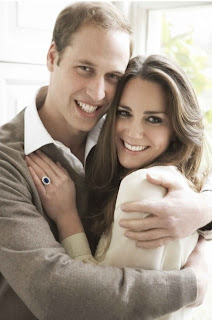
Are you anticipating the wedding of Prince William and Kate Middleton? I am. I think they are such an appealing couple; I’m really hoping they achieve a happily ever after.
To celebrate the Royal Wedding this April 29, Harlequin Historical had this really creative idea—short stories set during real historical royal weddings!
Here is what Senior Editor Linda Fildew said about them:
“These seven short stories brilliantly capture the drama, pomp and ceremony and high passion of real-life royal weddings. From Eleanor of Aquitaine to Queen Victoria, these royal romances through the ages bring history vividly to life.”
As you might imagine, the authors had only a short time to research and write these stories. It was up to each of them to decide to use the royal couple as the hero and heroine or to choose other characters.
The books are available now at eHarlequin.com (scroll down), MillsandBoon.co.uk (scroll down), Amazon, and other email vendors.
Here are the stories and the royal couples the story celebrates:
 Terri Brisbin’s WHAT THE DUCHESS WANTS (Eleanor, Duchess of Aquitaine and Henry of Anjou, the future Henry II, 1152)
Terri Brisbin’s WHAT THE DUCHESS WANTS (Eleanor, Duchess of Aquitaine and Henry of Anjou, the future Henry II, 1152)
–As one of Europe’s most powerful women, Eleanor, Duchess of Aquitaine, has a chance most can only dream of—to choose her own husband! One glance at the young, forceful Henry of Anjou and her choice is made. Able to match her wit for wit, Henry’s a true warrior and not afraid to disobey a royal command… But his love of life—and the bedroom—promises Eleanor a brand-new world of excitement!
 Michelle Willingham’s LIONHEART’S BRIDE (King Richard and Princess Berengaria, 1191)
Michelle Willingham’s LIONHEART’S BRIDE (King Richard and Princess Berengaria, 1191)
–Princess Berengaria’s lady-in-waiting, Adriana, takes her duty to the future Queen of England seriously—she will defend her to the death! When their sea voyage to the Holy Land ends up in shipwreck and capture Adriana knows her only hope lies with the mysterious Irishman, Liam MacEgan. Liam escapes to reach Richard the Lionheart and together they plan a rescue mission. Nothing will stop these warriors from succeeding—their future brides are captive on Cyprus and they’ll raise hell to claim them!
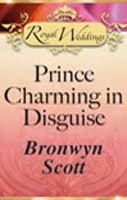 Bronwyn Scott’s PRINCE CHARMING IN DISGUISE (Prince George and Caroline of Ansbach, 1704)
Bronwyn Scott’s PRINCE CHARMING IN DISGUISE (Prince George and Caroline of Ansbach, 1704)
–He might be the future King of England, but Prince George seeks a marriage that’s more than a mere political alliance. Masquerading as a lowly nobleman, George heads to the court of Ansbach to woo the renowned beauty, Caroline! Caroline has no knowledge that he’s the most sought-after bachelor in Europe. But however much she’s charmed by the mysterious gentleman, her duty is to accept a blue-blooded proposal… Still, she cannot deny she’s wickedly tempted by his red-hot proposition!
 Elizabeth Rolls’ A PRINCELY DILEMMA (George, Prince of Wales—future George IV—and Princess Caroline of Brunswick 1795)
Elizabeth Rolls’ A PRINCELY DILEMMA (George, Prince of Wales—future George IV—and Princess Caroline of Brunswick 1795)
–George, Prince of Wales, with his mistress in tow, only lays eyes on Princess Caroline of Brunswick three days before their wedding, and his resentment is palpable. Christopher, Duke of Severn, knows all about arranged marriages—his new wife’s fortune is the reason plain Linnet is wearing his ring! Severn and Linnet must persuade the spoilt princeling and his soon-to-be bride that a paper marriage can become something more. But in trying to convince the royal couple, a tantalizing spark ignites between the duke and his convenient duchess…
 Ann Lethbridge’s PRINCESS CHARLOTTE’S CHOICE (Princess Charlotte and Prince Leopold, 1816)
Ann Lethbridge’s PRINCESS CHARLOTTE’S CHOICE (Princess Charlotte and Prince Leopold, 1816)
–As Princess Charlotte prepares to marry Prince Leopold, her most trusted lady, Isabelle Fenwick, must remain chaste and beyond scandal. Yet she has never forgotten darkly handsome Count Nikkolae Grazinsky and the kiss he stole…She later discovered the Russian had only used her for a wager, so why does he still seek her company? And why does the air tingle with anticipation when they are together? Surely this rake cannot be thinking of following Prince Leopold’s example and making a love-match?
 Mary Nichols’ WITH VICTORIA’S BLESSING (Queen Victoria and Prince Albert, 1840)
Mary Nichols’ WITH VICTORIA’S BLESSING (Queen Victoria and Prince Albert, 1840)
–Preparations for the young Queen Victoria’s wedding have thrown all of London into a frenzy—but for Lady Emily Sumner, her own marital dilemmas eclipse all the excitement! Forbidden to marry her beloved Lieutenant Richard Lawrence by her strict, status-conscious mama, Emily’s chance at wedded bliss seems out of reach… But as Maid of Honour to the Queen, Emily discovers she has a secret weapon—royal approval! And with Queen Victoria’s blessing, surely Emily’s happy ending can’t be too far behind…?
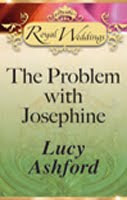 Lucy Ashford’s THE PROBLEM WITH JOSEPHINE (Emperor Napoleon and Archduchess Marie-Louise of Austria, 1810)
Lucy Ashford’s THE PROBLEM WITH JOSEPHINE (Emperor Napoleon and Archduchess Marie-Louise of Austria, 1810)
–It’s springtime in Paris and Emperor Napoleon is about to marry Archduchess Marie-Louise of Austria. All around the city Napoleon’s courtiers are preparing for the spectacularly lavish wedding. Everything must be just right…Ordered to remove all portraits of Josephine, the Emperor’s first wife, seamstress Sophie has to track down a talented artist called Jacques. He promises to carry out the commission, but only in return for a kiss for every hour he works…